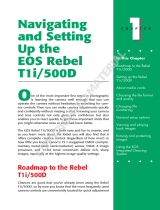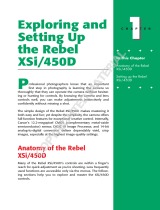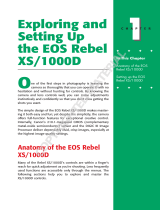Page is loading ...

EF-S60mm f/2.8 MACRO USM
Instruction
ENG
COPY

ENG-1
Thank you for purchasing a Canon product.
The Canon EF-S60mm f/2.8 MACRO USM lens
is a macro lens that can be used for normal
photography and close-up pictures up to 1:1,
or life-size magnification. It has been
developed for use with digital SLR cameras*
compatible with EF-S lenses.
¡“USM” stands for Ultrasonic Motor.
Features
1. The three-group floating system results in
excellent delineation at all focusing distances
from life-size to infinity.
2. A Canon macro flash makes it easy to take
close-up pictures with a flash. The inner
focusing mechanism enables AF photography
while the macro flash is attached.
3. Ultrasonic motor (USM) for quick and quiet
autofocusing.
4. Manual focusing is available after the subject
comes into focus in autofocus mode (ONE
SHOT AF).
Conventions used in this instruction
Warning to prevent lens or camera
malfunction or damage.
Supplementary notes on using the lens
and taking pictures.
*
As of February 2010, only the EOS 7D, EOS 50D,
EOS 40D, EOS 30D, EOS 20D, EOS 20Da, EOS
REBEL T2i/550D, EOS REBEL T1i/500D, EOS
REBEL XSi/450D, EOS REBEL XS/1000D, EOS
DIGITAL REBEL XTi/400D DIGITAL, EOS
DIGITAL REBEL XT/350D DIGITAL, and EOS
DIGITAL REBEL/300D DIGITAL are compatible
with EF-S lenses.
COPY

ENG-2
a Safety Precautions
• Do not look at the sun or a bright light source
through the lens or camera. Doing so could
result in loss of vision. Looking at the sun directly
through the lens is especially hazardous.
• Whether it is attached to the camera or not, do
not leave the lens under the sun without the
lens cap attached. This is to prevent the lens from
concentrating the sun’s rays, which could cause a
fire.
Handling Cautions
• If the lens is taken from a cold environment into
a warm one, condensation may develop on the
lens surface and internal parts. To prevent
condensation in this case, first put the lens into an
airtight plastic bag before taking it from a cold to
warm environment. Then take out the lens after it
has warmed gradually. Do the same when taking
the lens from a warm environment into a cold one.
• Do not leave the lens in excessive heat such as in
a car in direct sunlight. High temperatures can
cause the lens to malfunction.
This device complies with Part 15 of the FCC Rules. Operation is
subject to the following two conditions: (1) This device may not
cause harmful interference, and (2) this device must accept any
interference received, including interference that may cause
undesired operation.
Do not make any changes or modifications to the equipment
unless otherwise specified in the instructions. If such changes or
modifications should be made, you could be required to stop
operation of the equipment.
This equipment has been tested and found to comply with the
limits for a class B digital device, pursuant to part 15 of the FCC
Rules. These limits are designed to provide reasonable protection
against harmful interference in a residential installation. This
equipment generates, uses and can radiate radio frequency
energy and, if not installed and used in accordance with the
instructions, may cause harmful interference to radio
communications.
However, there is no guarantee that interference will not occur in
a particular installation. If this equipment does cause harmful
interference to radio or television reception, which can be
determined by turning the equipment off and on, the user is
encouraged to try to correct the interference by one or more of
the following measures:
• Reorient or relocate the receiving antenna.
• Increase the separation between the equipment and receiver.
• Consult the dealer or an experienced radio/TV technician for
help.
This Class B digital apparatus complies with Canadian ICES-003.
COPY

ENG-3
Nomenclature
Distance scale (→ 8)
Contacts (→ 4)
Focus mode switch
(→ 4)
Hood mount (→ 7)
Lens mount index (→ 4)
Filter mounting
thread (→ 9)
Macro flash
mount (→ 7)
Focusing ring (→ 4)
Distance index (→ 8)
For detailed information, reference page numbers are provided in parentheses (→ **).
COPY

ENG-4
1
Mounting and Detaching the Lens
See your camera’s instructions for details on
mounting and detaching the lens.
¡After detaching the lens, place the lens with the
rear end up to prevent the lens surface and
electrical contacts from getting scratched.
¡If the contacts get soiled, scratched, or have
fingerprints on them, corrosion or faulty
connections can result. The camera and lens
may not operate properly.
¡If the contacts get soiled or have fingerprints on
them, clean them with a soft cloth.
¡If you remove the lens, cover it with the dust
cap. To attach it properly, align the lens mount
index and the ¢ index of the dust cap as shown
in the diagram, and turn clockwise. To remove
it, reverse the order.
2
Setting the Focus Mode
After autofocusing in ONE SHOT AF mode, focus
manually by pressing the shutter button halfway
and turning the focusing ring. (Full-time manual
focus)
To shoot in autofocus (AF) mode, set the focus
mode switch to AF.
To use only manual focusing (MF), set the focus
mode switch to MF, and focus by turning the
focusing ring. The focusing ring always works,
regardless of the focus mode.
COPY

ENG-5
3
Picture Taking
Normal Photography
The lens can be used as a medium-telephoto
lens equivalent to 96mm in 35mm format for
normal photography such as snapshots and
portraits.
Closeup Photography
Close-up photos up to 1x (life-size) magnification
are possible. The minimum focusing distance of
20 cm is the distance from the subject to the
focal plane. The working distance from the front
of the lens to the subject is about 9 cm.
When focusing, you can give priority to framing
or to magnification.
[Framing Priority]
While looking through the viewfinder and framing
the subject, focus with the AF or MF mode.
[Magnification Priority]
1. Set the lens’ focus mode switch to MF.
2. Set the magnification.
While referring to the magnification scale on
the lens, turn the focusing ring to the desired
magnification.
¡Image quality deteriorates near the minimum
aperture opening due to diffraction.
¡The magnification refers to the ratio between the
subject’s size and the corresponding image size
on the focal plane. On the distance index, it is
indicated as 1:x.
¡To prevent camera shake, using a Remote
Switch (both sold separately) and tripod is
recommended.
¡To check the depth of field, press the camera’s
depth-of-field preview button.
3. Focus the subject.
While looking through the viewfinder, move the
camera forward or back to find the point of
focus.
4. Touch up the focus.
Turn the focusing ring for fine focusing.
Since macro shots have a very shallow depth of
field, focus carefully to obtain proper sharpness.
COPY

ENG-6
4
About Exposure
Setting the Exposure
When taking photographs using TTL
metering, no exposure compensation is
necessary to meter the light coming through
the lens.
With TTL metering, AE (autoexposure) is
possible at all focusing distances. Just set the
desired picture-taking mode, then check the
shutter speed and aperture before taking the
picture.
Magnification and Effective f-number
The aperture displayed by the camera assumes
that the focus is set to infinity. The actual aperture
(effective f-number) becomes darker (effective f-
number increases) at closer focusing distances
(magnification increases). This does not cause
exposure problems for normal picture-taking.
However, for closeup photography, you cannot
ignore the change in the effective f-number.
When you use a handheld exposure meter to
set the exposure, you must take into account
the exposure factor shown in the following
table.
Magnification 1 : 5 1 : 4 1 : 3 1 : 2
1:1.5
1 : 1
Effective f/No. 3.50 3.66 3.89 4.39 4.86 5.84
Exposure Factor
in stops
++ +1+1 +1 +2
(stops)
in stops
++ +1+1 +1 +2
2
3
1
3
2
3
2
3
1
3
1
2
1
2
1
2
1
2
¡The correct exposure for a close-up shot largely
depends on the subject. Therefore, it is
recommended to take several shots of the same
subject at different exposures.
¡When taking close-up shots, it is recommended
to use aperture-priority AE (Av) or Manual (M)
picture-taking modes, because depth of field
and exposure are easy to adjust in those
modes.
If your eye will not be covering the eyepiece when
the picture is taken (with remote control operation,
etc.), use the eyepiece shutter or eyepiece cover.
This prevents stray light from entering the
eyepiece and throwing off the proper exposure.
COPY

ENG-7
6
Hood (Sold Separately)
The ET-67B hood can keep unwanted light out of
the lens, and also protects the lens from rain,
snow, and dust.
Attach and align the hood to the hood mount on
the front of the lens, and turn the hood as shown
by the arrow to secure it.
The hood can be reverse-mounted on the lens
for storage.
¡Part of the picture may be blocked if the hood is
not attached properly.
¡When attaching or detaching the hood, grasp
the base of the hood to turn it. To prevent
deformation, do not grasp the rim of the hood to
turn it.
5
Macro Flash (Sold Separately)
The Canon Macro Ring Lite MR-14EX or the
Macro Twin Lite MT-24EX enables fully
automatic macro flash photography up to 1x
magnification in E-TTL autoflash mode.
¡For information on operating the Canon Macro
Ring Lite MR-14EX or the Macro Twin Lite MT-
24EX, refer to the individual instruction booklets.
¡Using aperture-priority AE (Av) or Manual (M) is
recommended.
MT-24EX
1
1:
11.5 1.5223355
MR-14EX
Flash Range (ISO100)
2.8
4
5.6
8
11
16
22
32
f-number →
Magnification →
: Flash range
Flash Head Angle
Settings for MT-24EX
1 : 1 - 1 : 1.5
1 : 2
1 : 3
1 : 5
45°
30° 15°
Magnification
Inward Angle
of Flash Head
COPY

ENG-8
7
Infinity Compensation Mark
To compensate for shifting of the infinity focus
point that results from changes in temperature.
The infinity position at normal temperature is the
point at which the vertical line of the L mark is
aligned with the distance indicator on the
distance scale.
For accurate manual focusing on subjects at
infinity distance, look through the viewfinder while
rotating the focusing ring.
8
Close-up Lenses (Sold separately)
Attaching a 250D or 500D (52mm) Close-up
Lens enables close-up photography.
The magnification will be as follows.
¡Close-up Lens 250D: 1.33x - 0.25x
¡Close-up Lens 500D: 1.18x - 0.12x
Infinity Compensation Mark
Distance index
Manual focusing is recommended for accurate
focusing.
COPY

9
Filters (Sold Separately)
You can attach filters to the filter mounting
thread on the front of the lens.
¡This lens can accommodate both filters and the
macro flash at the same time.
¡If you need a polarizing filter, use the Canon
Circular Polarizing Filter (52mm).
¡To adjust the polarizing filter, first remove the
lens hood.
ENG-9
10
Extension Tubes (Sold Separately)
You can attach Extension Tube EF12 II or EF25
II for magnified shots. The shooting distance and
magnification are shown below.
Camera-to-Subject
Magnification
Distance (mm)
Near Far Near Far
EF12 II 207 445 1.28× 0.20×
EF25 II 215 289 1.61× 0.44×
Manual focusing is recommended for accurate
focusing.
COPY

ENG-10
11
Specifications
Focal Length/Aperture 60 mm f/2.8
Lens Construction 8 groups, 12 elements
Minimum Aperture f/32
Angle of View Diagonal: 24° 30’ Vertical: 14° 10’ Horizontal: 20° 40’
Min. Focusing Distance 0.2 m/0.7 ft.
Max. Magnification 1 ×
Field of View 15.1 × 22.7 mm/0.6 × 0.9 inch (at 0.2 m)
Filter Diameter 52 mm/2.0 inch
Max. Diameter and Length 73 × 69.8 mm/2.9 × 2.7 inch
Weight 335 g/11.8 oz
Hood ET-67B (Sold separately)
Lens Cap E-52U
Case LP1016 (Sold separately)
¡Equivalent to 96 mm in the 35mm film format.
¡The lens length is measured from the mount surface to the front end of the lens. Add 21.5 mm when including
the lens cap and dust cap.
¡The size and weight listed are for the lens only, except as indicated.
¡The EF1.4X II/EF2X II extenders cannot be used with this lens.
¡Aperture settings are specified on the camera.
¡All data listed is measured according to Canon standards.
¡Product specifications and appearance are subject to change without notice.
COPY

© CANON INC. 2005 2010.2CT1-7556-010
COPY
/






